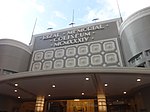Rizal Memorial Stadium
1934 establishments in the PhilippinesArt Deco architecture in the PhilippinesAsian Games athletics venuesAsian Games football venuesAthletics (track and field) venues in the Philippines ... and 10 more
Buildings and structures in Malate, ManilaFootball venues in the PhilippinesJuan M. Arellano buildingsNational stadiumsPages with non-numeric formatnum argumentsSoutheast Asian Games stadiumsSports venues completed in 1934Sports venues in ManilaStadiums of the Asian GamesVenues of the 1954 Asian Games

The Rizal Memorial Track and Football Stadium (simply known as the Rizal Memorial Stadium; officially the Simeon Toribio Track Stadium) is the main stadium of the Rizal Memorial Sports Complex in Manila, Philippines. It served as the main stadium of the 1954 Asian Games and the Southeast Asian Games on three occasions. The stadium is also officially the home of the Philippines national football teams and domestic matches.
Excerpt from the Wikipedia article Rizal Memorial Stadium (License: CC BY-SA 3.0, Authors, Images).Rizal Memorial Stadium
Adriatico Street, Manila Malate (Fifth District)
Geographical coordinates (GPS) Address External links Nearby Places Show on map
Geographical coordinates (GPS)
| Latitude | Longitude |
|---|---|
| N 14.563402777778 ° | E 120.992 ° |
Address
Rizal Memorial Track and Football Stadium
Adriatico Street
1004 Manila, Malate (Fifth District)
Philippines
Open on Google Maps








